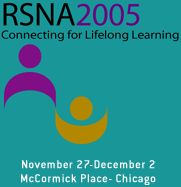
Abstract Archives of the RSNA, 2005
SSK02-09
In Vivo Identification of Upper Thoracic Aorta and Arch Vessel Complicated Atherosclerotic Plaque by Magnetic Resonance Direct Thrombus Imaging (MRDTI) in Patients Investigated for Symptomatic Anterior Circulation Cerebrovascular Disease
Scientific Papers
Presented on November 30, 2005
Presented as part of SSK02: Vascular/Interventional (MR Angiography)
Richard Bitar MD, Presenter: Nothing to Disclose
Alan Rowland Moody MD, Abstract Co-Author: Nothing to Disclose
General Leung, Abstract Co-Author: Nothing to Disclose
Alexander Kiss PhD, Abstract Co-Author: Nothing to Disclose
David J Gladstone MD, Abstract Co-Author: Nothing to Disclose
D James Sahlas MD, Abstract Co-Author: Nothing to Disclose
Susan J Crisp, Abstract Co-Author: Nothing to Disclose
Andrew Nelson, Abstract Co-Author: Nothing to Disclose
Robert Maggisano MD, Abstract Co-Author: Nothing to Disclose
et al, Abstract Co-Author: Nothing to Disclose
To assess the feasibility of MRDTI, a T1-weighted volumetric technique that exploits the T1-shortening effects of methemoglobin, directly visualizing intraplaque hemorrhage/thrombus and therefore complicated plaque (American Heart Association Type VI), to evaluate the prevalence and location of upper thoracic aortic and arch vessel complicated plaque in patients referred for evaluation of symptomatic anterior circulation cerebrovascular disease.
Two hundred and sixty nine patients (157 male, 112 female, mean age 66.9 ± 14.9 years) symptomatic for TIA/amaurosis fugax, acute or remote infarct were scanned using a 1.5T GE Twin Speed MR (GE Medical systems, USA), and an 8-channel neurovascular phased-array coil (USA Instruments, USA). The MRDTI sequence used a free-breathing 3D T1-weighted fat-suppressed spoiled gradient echo (TR/TE/α 6.7ms/1.7ms/Fr, 15º), FOV 300mm², effective voxel size 0.94mm²x 1.0mm, 3NEX. Fat suppression was achieved using SPECIAL (Spectral Inversion At Lipids), a GE proprietary technique.
Thirty-seven of 269 patients (13.8%) had upper thoracic aortic and/or arch vessel complicated atherosclerotic disease. The upper thoracic aorta was involved in 30/37 patients (81%), 3/37 (8.1%) proximal to left subclavian artery, and 27/37 (73%) distal to left subclavian. Complicated plaque was also seen in the left subclavian (10/37 patients, 27%), the right subclavian (1/37, 2.7%) and brachiocephalic artery (1/27, 2.7%). Complicated carotid plaque was seen in 22/37 patients (60%).
MRDTI can be applied in the detection of complicated plaque in the upper thoracic aorta and arch vessels. Complicated plaque was identified in 14% of the patient population. The upper thoracic aorta distal to the left subclavian artery was the most common site involved.
R.B.: Dr. Richard Bitar is the recipient of a Canadian Heads of Academic Radiology (CHAR) Resident Grant, and a Canadian Institutes of Health Research (CIHR) Research Fellowship
Bitar, R,
Moody, A,
Leung, G,
Kiss, A,
Gladstone, D,
Sahlas, D,
Crisp, S,
Nelson, A,
Maggisano, R,
et al, ,
In Vivo Identification of Upper Thoracic Aorta and Arch Vessel Complicated Atherosclerotic Plaque by Magnetic Resonance Direct Thrombus Imaging (MRDTI) in Patients Investigated for Symptomatic Anterior Circulation Cerebrovascular Disease. Radiological Society of North America 2005 Scientific Assembly and Annual Meeting, November 27 - December 2, 2005 ,Chicago IL.
http://archive.rsna.org/2005/4408300.html

